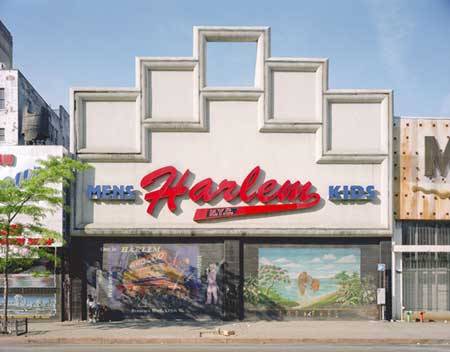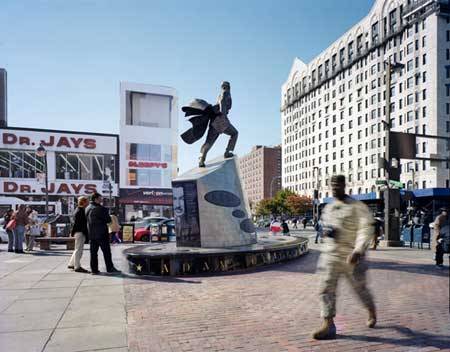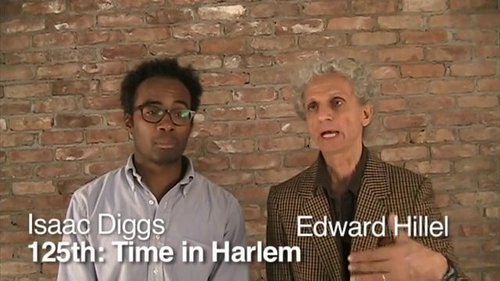Meet a NYFA Artist: Isaac Diggs
NYFA speaks to Isaac Diggs (NYFA/Artspire Fiscally Sponsored Artist) about his project in collaboration with Edward Hillel, 125th: Time in Harlem, which examines 125th Street in Harlem, and issues facing the neighborhood. The project consists of a series of images on display at the Claire Oliver Gallery in NYC, a book, out in December, and a series of public programs.
NYFA: You are currently working with Edward Hillel on 125th: Time in Harlem, a project that explores 125th Street in Harlem, and the past and possible future of the neighborhood. What personal significance does Harlem have for you?
ID: I started visiting Harlem after moving to NY in 1990, and I lived in the Mount Morris Park area from 1995 to 2006. Harlem is really where I discovered myself as a photographer. I walked its streets photographing, and responding to whatever moved me, whether people or objects or particular spaces. Harlem never disappointed in terms of visual stimulation, and I was always aware of the history of the place and just who had walked these streets before I arrived. Harlem also felt wide open. The boulevards were wide and the buildings relatively low. Light itself felt different uptown.
NYFA: You lived in Harlem for a number of years. Did you discover anything new or surprising about the neighborhood through making these images?
ID: I gained a new appreciation for the smaller details present on 125th often lost when traveling from A to B. That was one of the advantages of working with a camera that demanded we extend the time of looking.

NYFA: What was it like to collaborate with another artist? How did your different approaches enhance/challenge the creative process?
ID: Working with Edward expanded my practice and created a very stimulating dialogue around process and picture making. With a lot of trial and error we crafted an approach that allowed us to work together seamlessly. Working with one camera at the same time required talking through all of the decisions around vantage point, frame, etc. with each photograph. Our first images sometimes took over an hour to make as we stood there talking on the street corner! As we worked, a “third” photographer emerged who worked much more quickly.
NYFA: Your project not only showcases a series of images, but also directly engages the community where the images were made. What do you hope viewers will take away from the project?
ID: Edward and I hope the images will inspire viewers to think more deeply around issues of community and how it is shaped by space. What’s going to happen to 125th St. and Harlem as buildings that have anchored corners for decades come down? What happens to those lost businesses and to those people? Change and flux in cities is a constant. How should this constant process be handled in a culturally rich and historically significant community like Harlem?

NYFA: You chose to make street photography with a 4X5 film camera on a tripod. On such a busy, often chaotic street, what effect did this deliberate and slow process have on your work?
ID: The 4×5 camera helped us achieve two important goals: 1) composing on the ground glass of a tripod mounted camera facilitated conversation between the two of us and helped foster collaboration – we weren’t in a rush, and 2) the camera describes surfaces with incredible detail and we wanted to bring this level of detail to the images. Currently printed at 40"x50", small details almost unseen at smaller print sizes now resonate.
NYFA: How did working with NYFA’s Fiscal Sponsorship program, Artspire, shape the project and your approach to it?
ID: We became involved with NYFA as we were looking for ways to raise money to realize the project as an exhibition and book. Gaining fiscal sponsorship was essential to attracting certain funders to the project.

NYFA: What are some of your favorite places in Harlem for food, and/or people-watching?
ID: Unfortunately one of my favorite places for food on 125th closed during the time we where working – M&Gs diner. The plaza in front of Adam Clayton Powell Boulevard is a great place to watch people, along with the subway entrances that dot 125th.
NYFA: Congratulations on your exhibition at the Claire Oliver Gallery and your upcoming book launch. What is next for the project and for you as an independent artist?
ID: 125th: Time in Harlem is currently on exhibit at the Claire Oliver Gallery through the beginning of December and the book will be out late December. You can pre-order a book now by going to the project website – www.125timeinharlem.org – or visiting our page on Rockethub. Edward and I continue to work together and are developing future projects.
—Interview conducted by Katherine Booth



